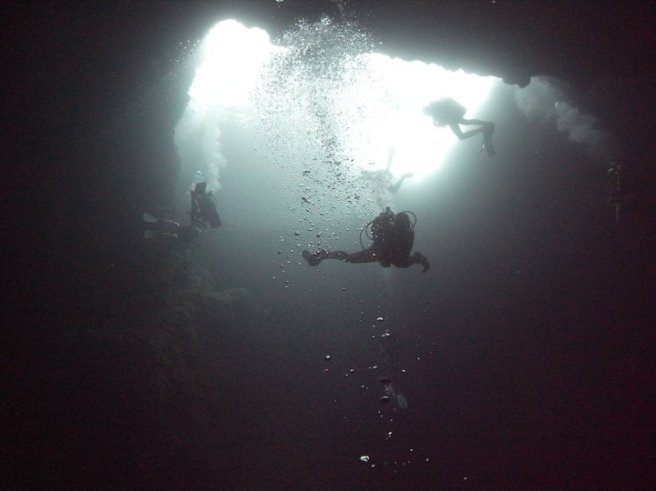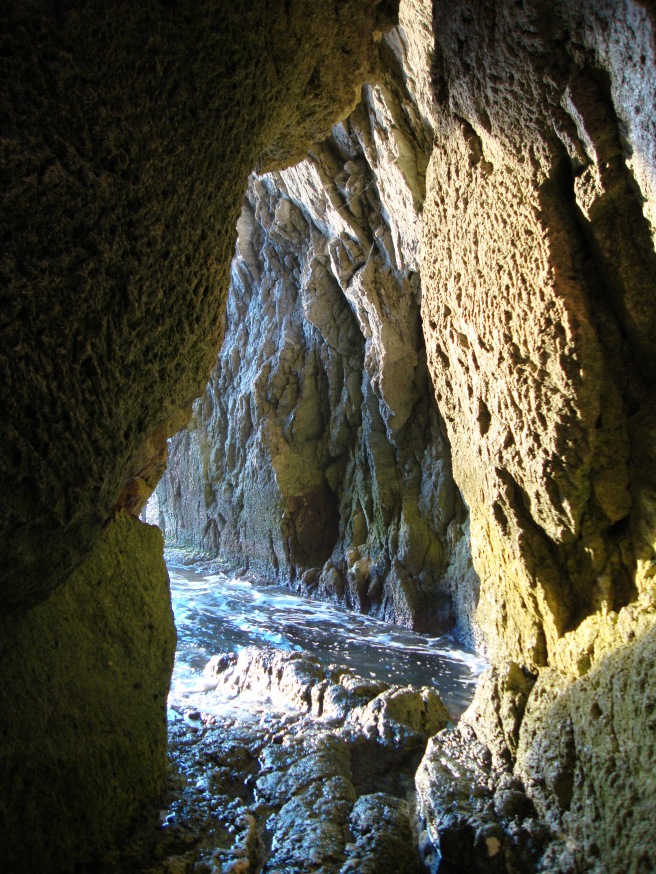
Even after all the talk about Sensei and I doing an over-a-hundred-metre dive, it came to me as a surprise, when, after doing 75 metres in Ras Il Hobs, Gozo, on Esclavo’s Tec Trimix course, Sensei said we would be doing 100 metres in two days’ time. I must say, I didn’t take it too seriously – I’d heard the same thing promised me one too many times before. Granted, it was a bit different this time: four twinsets had gases with an MOD of 107 metres in them, ready to dive, and a couple of new stage regs have been purchased… From experience, however, I knew all too well that twinsets can be left for ‘another day’ or re-blended, or simply drained, and regs are always handy.
On our way back from Gozo I found out that my brand new dry suit was waiting for me at the office. I’d not dived in a dry suit for about two months and had never used one to such depths. Also, I’d never used a separate inflation system on a dry suit – which I would have to do on the 100-metre dive to avoid Helium-related problems (isobaric counterdiffusion). ‘That’s two pieces of equipment I’m not particularly familiar with,’ I thought to myself.
We came back from Gozo, where we’d been diving that day, rather late and agreed on making the plan and doing the rest of gas blending the next day. When I walked into the dive centre in the morning, I was told I would be teaching EFR. Thus, I spent most of the day with ‘Annie’ and a Divemaster candidate, doing chest compressions and bandaging limbs. Late in the afternoon Sensei suggested I go in the water and try my new suit before I take it diving the next day. The suit passed the test of a quick dive on the house reef but I still wasn’t convinced I wanted to use it to over a 100 metres. Should I dive in three wetsuits instead? I would, but I knew all too well that under the pressure of over 11 bar I would have no buoyancy in a wetsuit – or three wetsuits – and my wing is a single bladder. It would have to be the dry suit.
When the working day was over, the tech team got together in the large classroom to make and discuss the dive plan. The four bottom divers would use TMx 12/55, 19/30 and EANx 32 and 72 during the dive; TMx 19/30 would be used as a travel gas as well as for decompression. It would be a 72-minute dive to 105 metres for me and another tech instructor. Sensei and Esclavo would go with us but stop and wait at 90 metres (max depth for last dive of the Tec Trimix course) – they would run the same dive plan my team mate and I would. However, the two teams would use different dive computers – Suunto’s for the 90-metre team and VR’s for us. We would have two support divers meet us at 40 metres with extra gas and to relieve us of the 19/30 stages. They would ascend with us to six metres and, once clear, hop out of the water and wait for us on the shore.

After leaving the dive centre that night I wasn’t feeling particularly calm. I was thinking about my busted eardrum, the new computer that had a very peculiar way of switching gases, the dry suit and what I would use to inflate it with and, of course, the three-digit depth I so wanted to reach. I went to sleep uncertain of what would happen, and if I would be able to deal with it.
The morning of the dive was rather nervy. My team mate, a safety diver and I were the first ones to arrive and analyze all our gases. I set my computer, packed my dry suit along with other bits and pieces and was ready to go. The rest of the divers arrived soon, together we loaded the van and headed for the ferry in Cirkewwa. A diving accident resulting, as we later found out, in a British diver’s death had just taken place there. The sound of rushing ambulances did not add to my sense of comfort that morning. The team, however, seemed cool and composed as ever, and it was looking at them that eventually made me feel better about the dive ahead of us.
Once in Ras Il Hobs, everything happened very quickly – as it would before, during and after any ‘normal’ dive. We got kitted up, walked into the slightly choppy water, had our stages clipped onto our rigs by the two safety divers and swam out towards the pinnacle. Next, the four of us did the checks, put our travel gas regulators in our mouths and headed down. At 40 metres we all switched to our back gas but then the two teams separated temporarily: the 90 metre divers had a bit more time to get down than us – my team mate and I had to kick fast to get to 100 metres on time. We hit 100 about 11 minutes into the dive, and, our computers showing 102 metres, we shook hands and signalled up, relieved. Our 90-metre friends were waiting for us to ascend to their depth so they could join us on the way up. Our first switch at 70 metres went smoothly. The second one, however, turned out to be more interesting. For some inexplicable reason I decided to switch to EANx 32% at 49 instead of 39 metres. I followed the procedure for switching, failing to spot the elephant, and only realised I was in trouble when I already had the new reg in my mouth. I looked at the depth on my computer – 49m, not 39, you IDIOT! – and spat the regulator out returning to the previous gas. My team mate looked terribly worried. I remember him reaching for me to pull the wrong reg out of my mouth but I didn’t give him a chance: if I was going to keep my life after all, I wanted to keep my teeth as well. The switch at 39m and the next one at 12m both went fine. Our safety divers, too, did a great job of helping us get rid of the floaty stages we no longer needed. The over-twenty-minute hang at 6 metres was fun with Sensei getting his wet notes out and congratulating my team mate and me on joining the 100-metre club. I also received the ‘Wanker Award’ – an ‘award’ for the biggest mess-up underwater – for nearly killing myself during the gas switch.

We were back on the surface and it was all over. I felt exhausted and stupid: my dry suit had done well, the computer worked fine, too – there had been no life-threatening equipment problems; what could have killed me was my lack of focus and my complacency. I distrust everything and everyone around me, yet I trust myself blindly and, obviously, it is wrong to do so.
Does it feel ‘special’ in any way to dive to 100 metres? I wouldn’t know. In the 72 minutes I spent underwater I didn’t have a moment to spare to really ‘feel’ anything. It is slightly disappointing that all I can say about going to 100 metres is that it’s stressful, difficult and tiring. Judging by how I felt after the dive physically, it’s not the healthiest pastime in the world, either. It is, however, a wonderful challenge and a test for those aware of the implications of failure. Would I do it again? Yes, I certainly would – I’m dying to go deeper.
P.S.: This story was written right after the dive, at the end of 2010. It will be the first of the series titled ‘One Day’ which I plan to write and post here. The stories will be accounts of some of the most memorable, exciting and the craziest days of my life so far. Should be fun!
